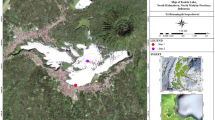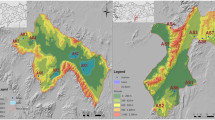Abstract
Littoral diatoms are important contributors of the primary production in shallow aquatic ecosystems and they can be used as indicators of the trophic status. The aim of the study was to develop an index to assess trophic status of Hungarian lakes as suggested by the Water Framework Directive. In spring of 2005 and 2006, epiphytic diatom samples were collected from 83 shallow lakes. Weighted average method was used to develop and test the TP model. In the developed TP model correlation between the observed and diatom inferred TP was high (r 2 = 0.96, n = 67). The optimum and tolerance TP parametrics of 127 species were determined and trophic indicator and sensibility values were defined for the Trophic Diatom Index for Lakes (TDIL). The TDIL was applicable to assess the ecological status of Hungarian shallow lakes. According to the TDIL the ecological status of 4 lakes were in excellent, 25 in good, 21 in medium, 21 in tolerable and 12 in bad status.


Similar content being viewed by others
References
Alefs, J., J. Müller & S. Wunsam, 1996. Die Rekonstruktion der epilimnischen Phosphorkonzentrationen im Ammersee seit 1958. GWF Wasser Abwasser 137/8: 443–447.
Ács, É., N. M. Reskóné, K. Szabó, Gy. Taba & K. T. Kiss, 2005. Application of benthic diatoms in water quality monitoring of lake Velence – Recommendations and assignments. Acta Botanica Hungarica 47: 211–223.
Anderson, N. J., B. Rippey & C. E. Gibson, 1993. A comparison of sedimentary and diatom-inferred phosphorous profiles: implications for defining pre-disturbance nutrient conditions. Hydrobiologia 253: 357–366.
Bennion, H., 1994. A diatom-phosphorous transfer function for shallow, eutrophic pond sin southeast England. Hydrobiologia 275/276: 391–410.
Besse-Lototskaya, A., P. F. M. Verdonschot & J. A. Sinkeldam, 2006. Uncertainty in diatom assessment: Sampling, identification and counting variation. Hydrobiologia 566: 244–278.
Birks, H. J. B., J. M. Line, S. Juggins, A. C. Stevenson & C. J. F. ter Braak, 1990. Diatoms and pH reconstruction. Philosophical Transactions for the Royal Society London 327: 263–278.
Blanco, S., L. Ector & E. Bécares, 2004. Epiphytic diatoms as water quality indicators in Spanish shallow lakes. Vie Milieu 54(2–3): 71–79.
Brabecz, K. & K. Szoszkiewicz, 2006. Macrophytes and diatoms – major results and conclusions from the STAR project. Hydrobiologia 566: 175–178.
Buczkó, K. & É. Ács, 1996/1997. Zonation of periphytic algae in two Hungarian shallow Lakes (Lake Velence and Fertő). Acta Botanica Hungarica 40: 21–34.
Castenholz, R. W., 1960. Seasonal changes in the attached algae of freshwater and saline lakes int he lower Grand Coulee, Washington. Limnology and Oceanography 5: 1–28.
Cemagref, 1982. Etude des Méthodes Biologiques Quantitative D’appréciation de la Qualité des Eaux. Rapport Q.E. Lyon-A.F. Bassin Rhone-Méditerranée-Corse, Lyon, France.
Comte, K., S. Fayolle & M. Roux, 2005. Quantitative and qualitative variability of epiphytic algae on one Apiaceae (Apium nodiflorum L.) in a karstic river (Southeast France). Hydrobiologa 543: 37–53.
Dell’Uomo, A. 1996. L’indice diatomico di eutrofizzazione/polluzione (EPI-D) nel monitoraggio delle acque correnti. Linee guida.
Descy, J. -P. & M. Coste, 1991. A test of methods for assessing water quality based on diatoms. Verhandlungen der Internationale Vereinigung für theoretische und Angewandte Limnologie 24: 2112–2116.
EC Parliament and Council, 2000. Directive of the European Parliament and of the Council 2000/60/EC Establishing a Framework for community action in the field of water policy. European Commission PE-CONS 3639/1/100 Rev 1, Luxembourg.
Fritz, S. C., 1989. Lake development and limnological response to prehistoric and historic land-use in Diss, Norfolk. Journal of Ecology 77: 182–202.
Furse, M., D. Hering, O. Moog, P. Verdonschot, R. K. Johnson, K. Brabec, K. Gritzalis, A. Buffagni, P. Pinto, N. Friberg, J. urray-Bligh, J. Kokes, R. Alber, P. Usseglio-Polatera, P. Haase, R. Sweeting, B. Bis, K. Szoszkiewicz, H. Soszka, G. Springe, F. Sporka & F. Krno, 2006. The STAR project: context, oblectives and approaches. Hydrobiologia 566: 3–29.
Hall, R. I. & J. P. Smol, 1992. A weighted-averaging regression and calibration model for inferring total phosphorous concentration from diatoms in British Columbia (Canada) lakes. Freshwater Biology 27: 417–434.
Harper, D., 1992. Eutrophication of Freshwaters. Chapmann Hall, London, UK, pp. 327.
Hickman, M., C. E. Schweger & D. M. Klarer, 1990. Baptise Lake, Alberta-a late Holocene history of changes in a lake and its catchments in the southern boreal forest. Journal of Paleolimnology 4: 253–267.
Hoagland, D. & Ch. G. Peterson, 1990. Effect of light and wave disturbance on vertical zonation of attached microalgae in large reservoir. Journal of Phycology 26: 450–457.
Hofmann, G., 1994. Aufwuchs-Diatomeen in Seen und ihre Eignung als Indikatoren der Trophie. Bibliotheca Diatomologica 30. pp. 241.
Hofmann, G., 1999. Trophiebewertung von Seen anhand von Aufwuchsdiatomeen. In Tümpling, W. & G. Friedrich (eds), Biologische Gewässeruntersuchung 2. pp. 319–333.
Istvánovics, V., A. Clement, L. Somlyódy, A. Specziár, L. G.-Tóth & J. Padisák, 2007. Updating water quality targets for shallow Lake Balaton (Hungary), recovering from eutrophication. Hydrobiologia 581: 305–318.
Kelly, M. G., 1998. Use of trophic diatom index to monitor eutrophication in rivers. Water Research 36: 236–242.
King, L., G. Clarke, H. Bennion, M. Kelly & M. Yallop, 2006. Recommendations for sampling littoral diatoms in lakes for ecological status assessments. Journal of Applied Phycology 18: 15–25.
Kitner, M. & A. Poulíĉková, 2003. Littoral diatoms as indicators for eutrophication of shallow lakes. Hydrobiologia 506–509: 519–524.
Kovács, C., M. Kahlert & J. Padisák, 2006. Benthic diatom communities along pH and TP gradients in Hungarian and Swedish streams. Journal of Applied Phycology 18: 105–117.
Krammer, K., 2002. Diatoms of Europe. Diatoms of the European Inland Waters and Comparable Habitats Vol. 1–4. A.R.G. Gantner Verlag K.G., Ruggel.
Krammer, K. & H. Lange-Bertalot, 1991–2000. Bacillariophyceae 1.-4. Teil: Naviculaceae. In: Pascher, A. (ed.), Süsswasserflora von Mitteleuropa. Band 2/1–4. Gustav Fischer Verlag, Heidelberg, Berlin.
Lange-Bertalot, H., 1995–2002. Iconographia Diatomologica. Annotated Diatom Micrographs Vol. 1.-9. Koeltz Scientific Books, Königstein.
Lenoir, A. & M. Coste, 1996. Development of a practical diatomic index of overall water quality applicable to the French National Water Board Network. In Rott, E. (ed.), 2nd Workshop on Algae for Monitoring Rivers, Innsbruck 18–19 Sept. 95, Studia Student. G.m.b.H., Innsbruck.
Müller, U., 1994. Seasonal development of epiphytic algae on Phragmites australis in an eutrophic lake. Archiv für Hydrobiologie 129: 273–292.
OECD, 1982. Eutrophicationof waters. Monitoring, assessment and control. Paris, 155 pp.
Padisák, J., 2005. Általános Limnológia [General Limnology]. ELTE Eötvös Kiadó, Budapest, pp. 310. [in Hungarian].
Padisák, J., G. Borics, I. Grigorszky & É. Soróczki-Pintér, 2006. Use of phytoplankton assemblages for monitoring ecological status of lakes within the Water Framework Directive: the assemblage index. Hydrobiologia 553: 1–14.
Persson, J., H. Hansson & I. Renberg, 2006. The Stone Brusher, a new sampler for submerged epilithic material in shallow streams and lakes. Hydrobiologia 560: 385–392.
Potapova, M. G., D. F. Charles, K. C. Ponader & D. M. Winter, 2004. Quantifying species indicator values for trophic diatom indices: a comparison of approaches. Hydrobiologia 517: 25–41.
Pote, D. H. & T. C. Daniel, 2000. Analyzing for TP and TDP in water samples. In Pierzynski, G. M. (ed.), Methods of Phosphorous Analysis for Soils, Sediments, Residuals and Waters. Kansas State University, Manhattan, 94–97.
Poulíčková, A., M. Duchoslav & M. Dokulil, 2004. Littoral diatom assemblages as indicators of lake trophic status: A casestudy from perialpine lakes in Austria. European Journal of Phycology 39: 143–152.
Prygiel, J. & M. Coste, 2000. Guide Méthodologique pour la mise en oeuvre de l’Indice Biologique Diatomées. NF T 90–354. Etude Agences de l’Eau-Cemagref Bordeaux, March 2000, Agences de l’Eau: 134
Reavie, E. D., J. P. Smol & P. J. Dillon, 2002. Inferring long-term nutrient changes in southeastern Ontario lakes: comparing paleolimnological and mass-balance models. Hydrobiologia 481: 61–74.
Reckhow, K. H. & S. C. Chapra, 1983. Engineering Approaches for Lake Managment. Volume 1: Data Analysis and Empirical Modeling. Butterworth, Boston, pp. 340.
Rott, E., E. Pipp, P. Pfister, H. van Dam, K. Ortler, N. Binder & K. Pall, 1999. Indikationslisten für Aufwuchsalgen in österreichischen Fliessgewässern. Teil 2: Trophieindikation (sowie geochemische Präferenzen; taxonomische und toxikologische Anmerkungen). Wasserwirtschaftskataster herasgegeben vom Bundesministerium f. Land- u.Forstwirtschaft, Wien. ISBN 3-85 174-25-4. pp. 248
Rott, E., E. Pipp & P. Pfister, 2003. Diatom methods developed for river quality assessment in Austria and a cross-check against numerical trophic indication methods used in Europe. Algological Studies 110: 91–115.
Round, F. E., 1991. Use of diatoms for monitoring rivers. In Whitton, B. A., E. Rott, & G. Friedrich (eds), Use of Algae for Monitoring Rivers. , Düsseldorf, pp 25–32.
Rumeau, A. & M. Coste, 1988. Initiation a la systematique des Diatomees d’eau douce pour l’utilisation pratique d’un indice diatomique generique. Bulletin Francais de la Peche et de la Pisciculture 309: 1–69.
Sandin, L. & P. F. M. Verdonschot, 2006. Stream and river typologies – major results and conclusions from the STAR project. Hydrobiologia 566: 33–37.
Schaumburg, J., C. Schranz, G. Hofmann, D. Stelzer, S. Schneider & U. Schmedtje, 2004. Macrophytes and phytobenthos as indicators of ecological status in German lakes – a contribution to the implementation of the Water Framework Directive. Limnologica 34: 302–314.
Schönfelder, I. & J. Gelbrecht, 2002. Relationship between littoral diatoms and their chemical environment in northeastern German lakes and rivers. Journal of Phycology 36: 66–82.
Shannon, C. E. & W. Wiener, 1949. The Mathematical theory of Communication. University of Illinois Press, Urbana, 125.
Soininen, J. & P. Niemelä, 2002. Inferring phosphorus levels of rivers from benthic diatoms using weighted averaging. Archiv für Hydrobiologie 154: 1–18.
Springe, G., L. Sandin, A. Briede & A. Skuja, 2006. Biological quality metrics: their variability and appropriate scale for assessing streams. Hydrobiologia 566: 153–172.
Stenger-Kovács, C., J. Padisák, É. Hajnal & K. Buczkó, in prep. Assessment of ecological status of natural inland saline (NaCO3, NaHCO3) lakes on basis of periphytic diatoms with modified index values of the Trophic Diatom Index for Lakes (TDIL). Hydrobiologia.
Stoermer, E. F. & J. P. Smol, 2001. The Diatoms: Application for the Environmental and Earth Sciences. Cambridge Universiy Press, UK, pp. 469.
Szilágyi, F., J. Padisák, E. Szalma & C. Kovács, 2004. Természetes tavak tipológiájának és specifikus referencia viszonyainak jellemzése. Zárójelentés. pp. 74. Characterization of the typology and specific reference status of natural lakes. Final report. [in Hungarian].
Taylor, D., C. Dalton, M. Leira, P. Jordan, G. Chen, L. León-Vintró, K. Irvine, H. Bennion & T. Nolan, 2006. Recent histories of six productive lakes in the Irish Ecoregion based on multiproxy paleolimnological evidence. Hydrobiologia 571: 237–259.
ter Braak, C. J. F. & H. van Dam, 1989. Inferring pH from diatoms: a comparison of old and new calibration methods. Hydrobiologia 178: 209–223.
van Dam, H., A. Mertens & J. Sinkeldam, 1994. A coded checklist and ecological indicator values of freshwater diatoms and ecological indicator values of freshwater diatoms from Netherland. Netherland Journal of Aquatic Ecology 28: 117–133.
van Dam, H., J. Padisák & C. Kovács, 2005. ECOSURV BQE Report Phytobenthos. Ministry of Environment and Water, Hungary.
Vollenweider, R. A., 1989. Global problems of eutrophication and its control. In Salánki, J. & S. Herodek (eds.), Conservation and Managment of Lakes. Akadémiai Kiadó, Budapest, 19–41.
Wetzel, R. G., 1990. Land-water interfaces: metabolic and limnological regulators. Verhandlungen der internationale Vereinigung für theoretische und angewandte. Limnologie 24: 6–24.
Wu, J. -T., 1999. A generic index of diatom assemblages as bioindicator of pollution in the Keelung River of Taiwan. Hydrobiologia 397: 79–87.
Zelinka, M. & P. Marvan, 1961. Zur Präzisirung der biologischen Klassifikation der Reinheit fliessender Gewässer. Archiv für Hydrobiologie 57: 389–407 http://www.campus.ncl.ac.uk/staff/Stephen.Juggins.
Acknowledgements
We thank Ms. Ildikó Királykuti for her help careful technical assistance in chemical analyses and Ms. Kata Kovács for her help in field samplings. This project was supported by the Ministry of Environment and Water (ECOSURV) and by the National Foundation for Research and Technology (NKFP 3B/022/2004).
Author information
Authors and Affiliations
Corresponding author
Additional information
Handling editor: K. Martens
Electronic supplementary material
Below are the electronic supplementary materials.
Rights and permissions
About this article
Cite this article
Stenger-Kovács, C., Buczkó, K., Hajnal, É. et al. Epiphytic, littoral diatoms as bioindicators of shallow lake trophic status: Trophic Diatom Index for Lakes (TDIL) developed in Hungary. Hydrobiologia 589, 141–154 (2007). https://doi.org/10.1007/s10750-007-0729-z
Received:
Revised:
Accepted:
Published:
Issue Date:
DOI: https://doi.org/10.1007/s10750-007-0729-z




